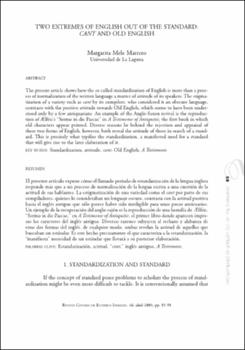Two Extremes of English Out of the Standard: Cant and Old English
Autor
Mele Marrero, Margarita
Fecha
2003Resumen
El presente artículo expone cómo el llamado período de estandarización de la lengua inglesa
responde más que a un proceso de normalización de la lengua escrita a una cuestión de la
actitud de sus hablantes. La estigmatización de una variedad como el cant por parte de sus
compiladores, quienes lo consideraban un lenguaje oscuro, contrasta con la actitud positiva
hacia el inglés antiguo que sólo parece haber sido inteligible para unos pocos anticuarios.
Un ejemplo de la recuperación del anglo-sajón es la reproducción de una homilía de Ælfric,
“Sermo in die Pascae,” en A Testimonie of Antiquitie, el primer libro donde aparecen impresos
los caracteres del inglés antiguo. Diversas razones subyacen al rechazo y alabanza de
estas dos formas del inglés, de cualquier modo, ambas revelan la actitud de aquellos que
buscaban un estándar. Es este hecho precisamente el que caracteriza a la estandarización, la
“manifiesta” necesidad de un estándar que llevará a su posterior elaboración. The present article shows how the so called standardization of English is more than a process
of normalization of the written language a matter of attitude of its speakers. The stigmatization
of a variety such as cant by its compilers, who considered it an obscure language,
contrasts with the positive attitude towards Old English, which seems to have been understood
only by a few antiquarians. An example of the Anglo-Saxon revival is the reproduction
of Ælfric’s “Sermo in die Pascae” in A Testimonie of Antiquitie, the first book in which
old characters appear printed. Diverse reasons lie behind the rejection and appraisal of
these two forms of English, however, both reveal the attitude of those in search of a standard.
This is precisely what typifies the standardization, a manifested need for a standard
that will give rise to the later elaboration of it.





